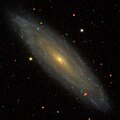NGC 3254
| Galaxie NGC 3254 | |
|---|---|
 | |
| Aufnahme mithilfe des Hubble-Weltraumteleskops | |
| AladinLite | |
| Sternbild | Kleiner Löwe |
| Position Äquinoktium: J2000.0, Epoche: J2000.0 | |
| Rektaszension | 10h 29m 19,9s[1] |
| Deklination | +29° 29′ 31″[1] |
| Erscheinungsbild | |
| Morphologischer Typ | SA(s)bc / Sy2[1] |
| Helligkeit (visuell) | 11,6 mag[2] |
| Helligkeit (B-Band) | 12,4 mag[2] |
| Winkelausdehnung | 4.50 × 1.4[2] |
| Positionswinkel | 46°[2] |
| Flächenhelligkeit | 13,4 mag/arcmin²[2] |
| Physikalische Daten | |
| Zugehörigkeit | LGG 197[3] |
| Rotverschiebung | 0.004520 ± 0.000003[1] |
| Radialgeschwindigkeit | (1355 ± 1) km/s[1] |
| Hubbledistanz H0 = 73 km/(s • Mpc) | (59 ± 4) · 106 Lj (18,0 ± 1,3) Mpc [1] |
| Durchmesser | 75.000 Lj[4] |
| Geschichte | |
| Entdeckung | William Herschel |
| Entdeckungsdatum | 13. März 1785 |
| Katalogbezeichnungen | |
| NGC 3254 • UGC 5685 • PGC 30895 • CGCG 154-020 • MCG +05-25-018 • IRAS F10265+2944 • 2MASX J10291992+2929291 • GC 2112 • H I 72 • h 714 • LDCE 734 NED002 | |
NGC 3254 ist eine Spiralgalaxie mit aktivem Galaxienkern vom Hubble-Typ Sbc im Sternbild Kleiner Löwe am Nordsternhimmel. Sie ist schätzungsweise 59 Millionen Lichtjahre von der Milchstraße entfernt und hat einen Durchmesser von etwa 80.000 Lj.
Im selben Himmelsareal befindet sich u. a. die Galaxie NGC 3265.
Das Objekt wurde am 13. März 1785 von Wilhelm Herschel entdeckt.[5]
- SDSS-Aufnahme
NGC 3254-Gruppe (LGG 197)
| Galaxie | Alternativname | Entfernung/Mio. Lj |
|---|---|---|
| NGC 3254 | PGC 30895 | 59 |
| NGC 3245 | PGC 30744 | 57 |
| NGC 3265 | PGC 31029 | 57 |
| NGC 3277 | PGC 31166 | 61 |
| PGC 30714 | NGC 3245A | 57 |
Weblinks
Einzelnachweise
Auf dieser Seite verwendete Medien
Autor/Urheber: Sloan Digital Sky Survey, Lizenz: CC BY 4.0

Angle of view: 4' × 4' (0.3" per pixel), north is up.
Details on the image processing pipeline: https://www.sdss.org/dr14/imaging/jpg-images-on-skyserver/Autor/Urheber:
Credit:
ESA/Hubble & NASA, A. Riess et al., Lizenz: CC BY 4.0A Galactic Powerhouse
This image shows the spiral galaxy NGC 3254, observed using Hubble's Wide Field Camera 3 (WFC3). WFC3 has the capacity to observe ultraviolet, visible and near-infrared light, and this image is a composite of observations taken in the visible and infrared. In this image, NGC 3254 looks like a typical spiral galaxy, viewed side-on. However, NGC 3254 has a fascinating secret that it is hiding in plain sight — it is a Seyfert galaxy, meaning that it has an extraordinarily active core, known as an active galactic nucleus, which releases as much energy as the rest of the galaxy put together.
Seyfert galaxies are not rare — about 10% of all galaxies are thought to be Seyfert galaxies. They belong to the class of “active galaxies” — galaxies that have supermassive black holes at their centres that are actively accreting material, which releases vast amounts of radiation as it is accreted. There is a second, far more active, type of active galaxy that is known as a quasar. The active cores of Seyfert galaxies, such as NGC 3254, are brightest when observed in light outside the visible spectrum. At other wavelengths, this image would look very different, with the galaxy’s core shining extremely brightly.
Credit:
ESA/Hubble & NASA, A. Riess et al.
Coordinates Position (RA): 10 29 23.83 Position (Dec): 29° 30' 6.70" Field of view: 2.41 x 2.03 arcminutes Orientation: North is 7.3° left of vertical Colours & filters Band Wavelength Telescope Optical Long pass 350 nm Hubble Space Telescope WFC3 Optical V 555 nm Hubble Space Telescope WFC3 Optical I 814 nm Hubble Space Telescope WFC3 Infrared H 1.6 μm Hubble Space Telescope WFC3.


